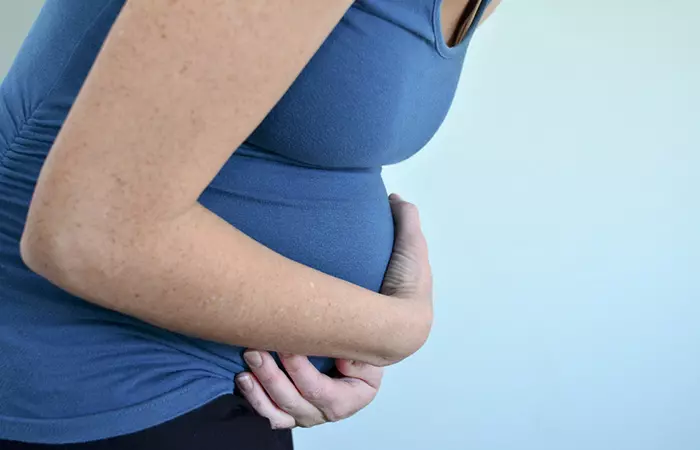Bloodroot: 5 Major Benefits, How To Use, And Side Effects
Boost your oral, cardiovascular, and respiratory health with this unique herb.

Image: ShutterStock
The rhizome of bloodroot (horizontal underground plant stem) contains a red liquid that renders it a blood-like appearance. Bloodroot benefits can be attributed to its medicinal properties and other important compounds. It is also known as bloodwort, Canada puccoon, and redroot. It has been traditionally used as a medicinal plant for decades. Native Americans used it to purify the blood, ease pain and fever, and treat wounds. Today many products use bloodroot for its many health benefits. What are these benefits? And, how can you use a bloodroot? Read on to understand more about bloodroot, its benefits, and any potential side effects.
 Know Your Ingredient: Bloodroot
Know Your Ingredient: BloodrootWhat Is It?
A perennial herbaceous flowering plant with white petals and a red root that is native to North America.
What Are Its Benefits?
Relieves constipation, improves oral health, boosts cardiovascular health, and treats sore throat, respiratory ailments, and wounds.
Who Can Use It?
Anyone except pregnant and breastfeeding women and individuals with low blood pressure.
How Often?
As part of your daily routine.
Caution
May cause a mild burning sensation, vomiting, diarrhea, rashes, and eye irritation in some individuals. Consult a doctor before you consume it or apply it on the skin.
In This Article
What Is Bloodroot? How Does It Work?
Bloodroot is scientifically known as Sanguinaria canadensis. This medicinal plant blossoms in spring and is mostly found in the eastern USA. It is majorly used to treat ailments like sore throat, respiratory discomfort, throat pain, and wounds. Bloodroot is taken orally or is applied topically to manage skin disorders. It is believed that it has chemical compounds that minimize the growth of microbes that cause skin conditions or respiratory ailments. To know more about the health conditions that can be managed by using bloodroot, scroll down to the next section.
 Trivia
TriviaKey Takeaways
- Bloodroot rhizome is an underground plant root with medicinal and therapeutic properties.
- With its antimicrobial properties, it can be taken orally or applied topically as well.
- It is available as wet pieces, dry powder, and capsule supplements for ease of use and consumption.
Health Benefits Of Bloodroot
1. May Fight Skin Cancer
Research shows that the active compound in bloodroot, sanguinarine, has the potential to be effective against skin cancer
(1). However, these claims are not backed by sufficient research. Hence, you should be aware of the usage and potential negative effects of bloodroot before using it on the skin. It is recommended to consult a doctor before you start using this herbal medicine.
2. May Promote Oral Health

Research shows that bloodroot is majorly used for treating periodontal diseasei An infection caused by bacteria in the mouth affecting the dental tissues, resulting in gum inflammation and can destroy the jawbone. and gingivitisi A common and mild form of gum disease that causes irritation, redness, and swelling of your gingiva (gums). and for remineralization of enamel lesionsi An abnormal change, growth, or damage of the tissue within or outside the body that might or might not be cancerous. ??(2). However, its exact mechanism of action in these treatments remains unclear.
A study has also shown that bloodroot, when mixed with mouthwash and toothpaste, exhibited a slight beneficial effect on gingivitis owing to its anti-inflammatory properties (3). However, more research is required to understand the detailed mechanism of action at play here.
3. May Promote Respiratory Health
In a study conducted in Australia, it is stated that bloodroot is used as a bronchial muscle relaxant for relieving asthma (4).
According to a CDC report, a total of 7.8% (25,257,138) of the US population is affected by asthma. The prevalence of asthma among children is 5.8% (4,226,659), and among adults is 8.4% (21,030,479). The prevalence of asthma attacks is 41% (10,342,170).
It is also used to treat inflammation of the larynx and trachea, which causes difficulty in breathing (known as croup), especially in children. However, the exact mechanism remains unclear, and it is advised not to take bloodroot on your own. Consult a doctor if you want to take bloodroot as a natural remedy for managing asthma or any other respiratory illness.
4. May Promote Cardiovascular Health

Research shows that bloodroot has a positive inotropic effect on the heart. This effect helps the heart to pump more blood with lesser contractions (4). This helps improve the functioning of the heart. Despite the claimed promotion of cardiovascular health, bloodroot should not be administered on its own. You should consult your doctor before taking bloodroot to improve your heart health.
5. May Help In Relieving Constipation
Anecdotal evidence suggests that bloodroot can relieve constipation to some extent by increasing the number of bowel movements.
But, it should only be used under medical supervision as it may induce diarrhea if you exceed the dosage.
 Fun Fact
Fun FactAll these benefits of bloodroot are dependent on the method of its preparation. Keep reading to learn about the preparation of bloodroot and how to use it.
How To Prepare And Use Bloodroot
Bloodroot is generally available in the form of dried powder or semi-wet pieces. The pieces can be cleaned, crushed, and boiled for further usage, while the dry powder can be used to make tea. Bloodroot is also available in the form of plant-based medicines or capsules that are taken as a supplement.
There are many ways that bloodroot is used as a home remedy:
- It is generally crushed and applied as a paste on the affected area.
- It is mixed with other ingredients like honey when applied topically.
- It is cut into fine pieces and boiled with oils like olive or coconut oil. This mixture can be stored in a glass bottle after straining.
- Alternatively, you can also boil crushed or chopped bloodroots with a cup of water for 15 minutes and strain them. The extract can be stored for 1 or 2 days in a glass bottle.
To use bloodroot topically, you can directly apply the paste or strained extract. However, if you are using it as a herbal remedy for treating any ailment or even as a supplement, it is highly recommended to consult a doctor as bloodroot may cause side effects if taken in excess.
Keep reading the next section to learn about its recommended dosage.
Recommended Dosage
Bloodroot tea can be had thrice a day. If you are taking bloodroot capsules as a supplement, one capsule per day after meals is generally recommended. However, it is highly recommended to consult a doctor before you start consuming bloodroot.
Learn how to select and store bloodroot in the next section.
Selection And Storage
Bloodroot is mostly available in the form of semi-wet pieces. Always choose bloodroots that are dark brownish in color and avoid the ones with white or gray patches. Select the ones with a thick and stout appearance with tiny hairs all around.
To store the bloodroot, wipe it with a dry cloth and allow it to air-dry for a few minutes. You can store it in a plastic box or glass container for 10-15 days in a refrigerator. Do not freeze it as it may lose its medicinal value.
If you want to store bloodroot for longer durations, dry it completely, wrap it in a muslin or cotton cloth, and store it in an air-tight container. It can be stored this way for up to one year. Before you store it in any form, you need to follow a few safety precautions to handle bloodroot. Read on to know more.
Safety Precautions
Bloodroot blossoms with pink or white flowers. Anecdotal evidence suggests that touching these flowers or the rhizome with bare hands can cause rashes. Hence, you need to follow some safety precautions:
- Always wear gloves before handling bloodroot.
- Do not inhale the flowers or rhizomes as they may cause slight respiratory discomfort.
- Keep the bloodroot flowers and powder away from your eyes as they may irritate them and cause a mild burning sensation.
- While crushing or chopping wet bloodroot, use a clean chopping board without any residue on it. After chopping it, clean the board with plenty of water as the bloodroot may stain it.
- After handling bloodroot, wash your hands with soap and water thoroughly.
Many folk remedies have used bloodroot for skin tag removal. Anecdotal reports claim that bloodroot may make skin tags shrivel and fall off by themselves. However, such claims have not been clinically proven and are not recommended by medical experts.
Some people also advocate using bloodroot for pimples. This use of bloodroot is not grounded in scientific research either. In fact, as already mentioned above, improper handling and direct application of bloodroot to compromised skin can worsen wounds, skin irritation, and inflammation. Hence, practice caution when using bloodroot as a topical solution for your skin-related concerns. If you are unsure about its usage, consult a doctor for further information.
Despite all the medical advice and precautions, bloodroot may cause some undesirable side effects. Continue reading to learn all about these side effects.
Possible Side Effects
Despite its many claimed benefits, bloodroot may cause some side effects if taken on its own. Anecdotal evidence suggests that if it is consumed or applied in excess, it can cause the following side effects:
1. May Cause Rashes and Scars
Bloodroot, when touched directly, may cause a rash or a scar that may take a long time to go away as it may slow down wound healing. It may also cause a burning sensation and itching.
2. May Lower Blood Pressure

Bloodroot contains sanguinarine, which is believed to lower your blood pressure. Therefore, people with low blood pressure should avoid taking it even as a supplement.
3. May Cause Miscarriage

In ancient western medicine, bloodroot was used to induce abortion in humans and horses. So if you think you are pregnant, it is highly recommended not to take bloodroot even as a supplement.
4. May Induce Vomiting
Bloodroot may induce vomiting when taken in excess. At times, it may also be coupled with drowsiness, spinning sensation, and irritability. However, these are considered short-term side effects that subside on their own.
5. May Cause Diarrhea

Bloodroot may cause diarrhea if taken for longer durations. It can also cause stomach pain and abdominal discomfort. If you experience severe stomach pain and loose stools after consuming bloodroot, consult a doctor immediately.
Additionally, if you have allergies to similar plants, a health condition, or are on medication, it is best to be cautious with bloodroot. Always consult a healthcare provider first to avoid any possible interactions or side effects.
Infographic: All You Need To Know About Bloodroot
Bloodroot is popularly known for its medicinal properties, which help promote oral health and relieve constipation. You can apply it topically or take it as capsules, dried powder, or fresh roots. Check out the infographic below for the major benefits of bloodroot, along with some precautions to take while using it.

Illustration: StyleCraze Design Team
The benefits of bloodroot can be attributed to the bioactive compounds in it. It is used as a traditional remedy to fight skin cancer, promote oral health, and aid respiratory health. In addition, it helps promote cardiovascular health and relieves constipation. Bloodroot can be taken in the form of capsules, dried powder, or fresh roots that can be cleaned and crushed for usage. Bloodroot can be consumed as well as applied topically. However, if taken on its own, it may trigger rashes and scars, lower blood pressure, cause miscarriage, and induce vomiting and diarrhea. But taking it in moderation helps in reaping its benefits.
Frequently Asked Questions
Can bloodroot interact with medications?
There is no clear scientific evidence that bloodroot interacts with medications, but anecdotal evidence suggests that it is possible. So, it is best to talk to a healthcare provider before using it, especially if you are on other medications.
Is bloodroot black salve?
Though there are many variations of black salve formulations, bloodroot is one of the major components of black salve. The other common component is zinc chloride.
Can we use bloodroot for warts?
Blackroot is often used to reduce the size of warts. However, it is recommended to use bloodroot for warts under the guidance of a professional healthcare provider as in incorrect doses, bloodroot expresses some toxicity.
Is bloodroot the same as turmeric?
No, bloodroot is not the same as turmeric. The former is native to eastern North America and belongs to the family Papaveraceae, while the latter is native to the Indian subcontinent and Southeast Asia and belongs to the family Zingiberaceae. Unlike turmeric, bloodroot is not majorly used as a spice for cooling purposes. However, bloodroot sometimes goes with the common name turmeric along with other names like red puccoon, snakebite, red root, corn root, sweet slumber, and tetterwort.
Is bloodroot blood thinner?
No, bloodroot is not blood thinner. However, anecdotal evidence suggests that it may slow blood clotting and intensify the effects of blood-thinning medications.
Is Bloodroot a drug?
No, bloodroot is not a drug. It is a medicinal plant. Anecdotal evidence suggests that it was traditionally used by Native Americans for treating respiratory disorders like cough and cold, fever, and wound healing.
Can bloodroot be used for psoriasis?
Yes, anecdotal evidence suggests that bloodroot can be used for psoriasis. It can also be used for other skin issues like acne and eczema. However, no scientific research supports claims that bloodroot can treat skin disorders.
Can bloodroot be used to treat infections?
Yes, bloodroot can be used to treat infections. Evidence suggests that bloodroot or sanguinaria has been used for treating pneumonia usually encountered by HIV-infected individuals (5).
Illustration: Bloodroot: Health Benefits Preparation Application Risks

Image: Stable Diffusion/StyleCraze Design Team
Unveil the fascinating versatility of bloodroot, encompassing its toxicity, medicinal properties, and diverse applications. Explore how this plant can enhance your health and well-being in remarkable ways by watching the below video.
References
Articles on StyleCraze are backed by verified information from peer-reviewed and academic research papers, reputed organizations, research institutions, and medical associations to ensure accuracy and relevance. Read our editorial policy to learn more.
- Dermatologic uses of bloodroot: a review and reappraisal
https://pubmed.ncbi.nlm.nih.gov/33128472/ - Herbs: A Good Alternatives to Current Treatments for Oral Health Problems
https://www.researchgate.net/profile/Manjunath-Puranik/publication/291814094_Herbs_A_Good_Alternatives_to_Current_Treatments_for_Oral_Health_Problems/links/56a620f308ae6c437c1adb3f/Herbs-A-Good-Alternatives-to-Current-Treatments-for-Oral-Health-Problems.pdf - Rise and fall of oral health products with Canadian bloodroot extract
https://pubmed.ncbi.nlm.nih.gov/22318955/ - Sanguinaria canadensis: Traditional Medicine Phytochemical Composition Biological Activities and Current Uses
https://www.ncbi.nlm.nih.gov/pmc/articles/PMC5037693/ - Antiviral potentials of medicinal plants
https://www.ncbi.nlm.nih.gov/pmc/articles/PMC7114233/
Read full bio of Nilofar Pendhari
Read full bio of Aparna Mallampalli
Read full bio of Ravi Teja Tadimalla
Read full bio of Himanshi Mahajan























Community Experiences
Join the conversation and become a part of our empowering community! Share your stories, experiences, and insights to connect with other beauty, lifestyle, and health enthusiasts.